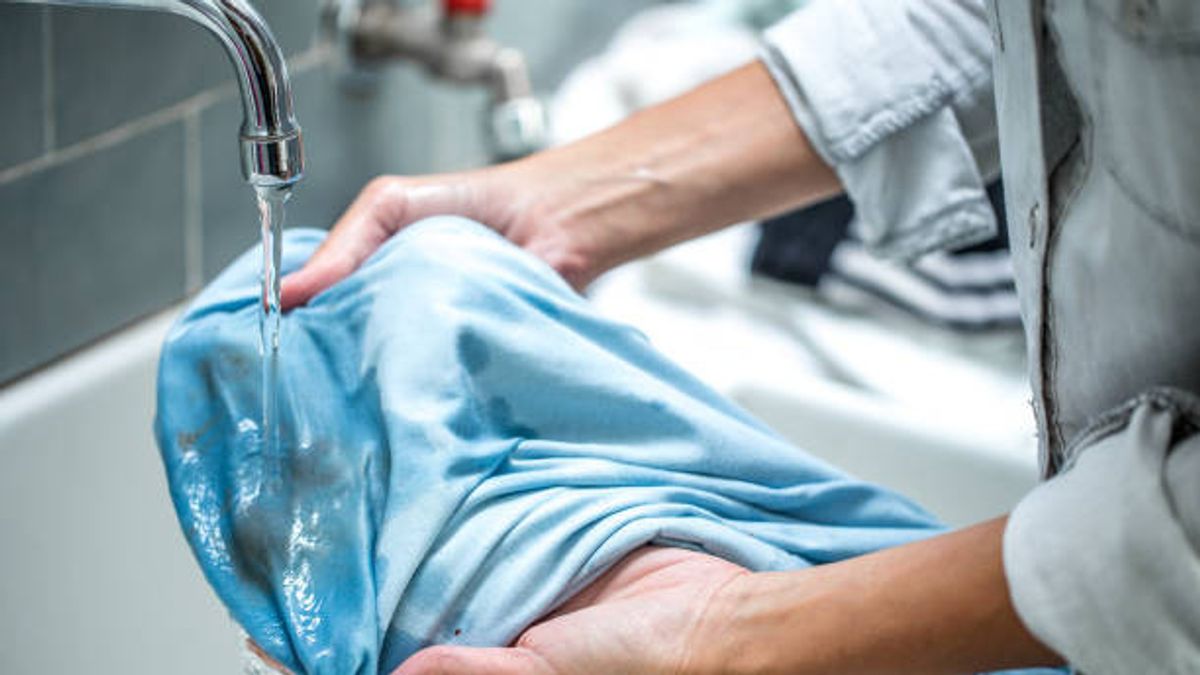JAKARTA - The nodes on the clothes are stubborn, but they may be eliminated easily. Even very difficult stains such as wine spills or ink can also be removed from most of the fabrics.
The key to removing the stain is to take action as soon as possible. Glotting or drying techniques with suction paper are usually better than sweeping. Bouting helps remove the stain from the cloth, while sweeping drives the stain deeper and can damage the fiber.
However, whatever method of removing the stain you choose, take time to test the hidden parts of clothing (for example, the bottom of the clothing) before proceeding. This is done to find out whether the cleaning method will damage the fabric.
Removing the stains on the washed cloth, such as acrylics, goni, cotton, denim, linen, nylon, polyester, and spardeks, is quite easy. While materials such as acetate, fiber glass, rayon, silk, triacetate, and transcendents are a bit complicated, but stains can still be removed with a few tricks. Follow the guidelines below to learn how to remove stains, even the heavy ones are reported from Better Homes and Gardens, Thursday, July 20.
How to care for ingredients that can be washed with machines: For new spots, soak in cold water, then wash. For dry spots, clean them first or soak in warm water with products that contain enzymes, then wash them. Enzymes are often recommended for protein-based stains, such as blood.
How to care for materials that cannot be washed: Flush the stain with cold water. Apply dilute white vinegar to the stain with a pipette. Rinse the stain with cold water.
How to care for materials that can be washed by machine: wash the cloth first with warm water and products that contain enzymes. Or use the stain removal product before washing. If the stain persists, wash the item with a clean bleach for the cloth.
How to care for things that cannot be washed out: apply dilute white vinegar to a stain with a pipette. Flush the area that is stained with cold water.
How to care for clothes that can be washed with machines: Sweep powder from clothes as much as possible. The first step is to remove it by removing stains or liquid detergents. Wash using the hottest water that is safe for cloth.
How to take care of clothes that cannot be washed: Sweep the powder from clothes as much as possible, then take it to a professional shop.
How to care for objects that can be washed by machine: Swab liquid dish washing soap into a stain with a clean cloth. You can also use removing the stain before washing with hot water. This method also works to remove oil stains from jeans.
How to care for materials that cannot be washed: Take them to a professional shop.
How to care for materials that can be washed with machines: Treat first with a stain remover and wash as usual. If the stain persists, place the tissue on the stain. Store the area around the stain with alcohol that is changed before applying the solvent to the stain. Often replace the paper towel when it's wet. Rinse it well and wash it.
As an alternative method, do it on the inside of the clothes by placing a cloth on the mouth of the jars or glass. Hold the cloth tightly so that the ink stains don't spread. Drop alcohol on the cloth. When the solvent leaves the cloth, the ink will fall into the container. Wash and wash it thoroughly.
How to care for materials that cannot be washed: For a solution of 1 part of glycerin, 1 part of the detergent of clear dish wash, 8 parts of water, and several drops of white vinegar. Dissolve the solution that has been made to a stain. Leave it 30 minutes, add more solutions so that the stain remains humid and then rinse until it is clean.
How to care for materials that can be washed with machines: Kikis as much as possible mold from the surface by gently brushing using a clean toothbrush. For white objects, mix 1 piece of bleach with 3 parts of water and apply the solution to the stain.
Keep it for a few minutes, then wash it with the hottest water temperature recommended for the material. To deal with moldy stains on colored clothes, spray white vinegar directly on the stain or cover it with a clean cloth wet with vinegar, let it absorb for a few minutes.
If possible, let the cloth dry up in direct sunlight, which can also help kill the fungal spora. Repeat this process as needed, then wash it as usual. If the stain persists, take the cloth to a professional shop.
How to take care of things that cannot be washed: Take them professionally.
另请阅读:
How to care for ingredients that can be washed with machines: Cover the stain with salt and stretch the cloth on a bowl. Pour the boiling water on the stain. If the stain persists, apply dilute white vinegar with a pipette. Rind with cold water and wash.
How to care for an object that cannot be washed: apply dilute white vinegar to a stain with a pipette. Flush the place where the stain is covered with cold water.
How to care for materials that can be washed with machines: Soak items in cold water and detergent solutions for 20 minutes. If the cloth is safe for bleaching, soak in a diluted bleach solution. Wash immediately with cold water and use ordinary determinants. If possible, dry in the sun to help fade turmeric, then wash again.
How to care for things that cannot be washed: Flush the stains with cold water. If the stains still exist, bring clothes to the professional shop.
The English, Chinese, Japanese, Arabic, and French versions are automatically generated by the AI. So there may still be inaccuracies in translating, please always see Indonesian as our main language. (system supported by DigitalSiber.id)


















